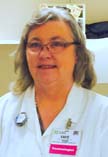May Skeleton Crew meeting to explore bone density tests
 DEXTER — The evaluation of bone mineral density (BMD) is done with the DXA or bone densitometry test. This test was known as the dual-energy X-ray absorptiometry or DEXA test. Whatever term we chose DXA or DEXA, the X-ray is today’s standard for measuring bone mineral density for the diagnosis of osteoporosis and for monitoring the course of bone loss treatment.
DEXTER — The evaluation of bone mineral density (BMD) is done with the DXA or bone densitometry test. This test was known as the dual-energy X-ray absorptiometry or DEXA test. Whatever term we chose DXA or DEXA, the X-ray is today’s standard for measuring bone mineral density for the diagnosis of osteoporosis and for monitoring the course of bone loss treatment.
The hip and spine are the bones most frequently X-rayed to test for bone mineral density measuring the number of grams of calcium and other bone minerals in those bone segments. The DXA is quick and painless. While the DXA measures the bone mineral density, a nuclear bone scan, on the other hand, is used to detect cancer, infections, fractures and other bone abnormalities and is decidedly different from the DXA.
About 40 percent of postmenopausal women in the U.S. have low bone density or osteopenia, while another 7 percent have very low bone density or osteoporosis. It is recommended that all women over the age of 65 and some men over the age of 70 have their BMD tested. Some risk factors that may prompt testing in younger individuals include previous history of fractures, low body mass index, current smoking, history of parental fractures, alcohol consumption of three or more units each day, glucocorticoid treatment, rheumatoid arthritis, organ transplant and thyroid disease.
DXA test scores can be confusing when a patient receives them from the healthcare provider. There is the T-score that measures the difference between your bone density and that of a healthy 30-year-old as well as determining if you have osteopenia, osteoporosis or are at risk of breaking a bone.
There is the Z-score that compares the amount of bone you have with that of other people of your age, race and gender. A Z-score that is too high or too low means that you may need more testing. And, there is the FRAX score, a compilation measure designed by the World Health Organization, calculated by using your total fracture risk as determined by the DXA scores plus personal risk factors, previously described as DXA prompts for younger individuals. Understanding these scores and the implications for treatment can sometimes be difficult.
There is so much to consider when looking at the test results. On Friday, May 6 at 2 p.m. at the Abbott Memorial Library, Faye Lique, radiological technician from St. Joseph’s Hospital, will speak to the Skeleton Crew audience about how to interpret DXA test results.
Lique graduated from Forsyth Technical College in 1977 with honors. She has extensive experience in the field of DXA testing working as early as 1979 at one of the first BMD units in the country with researcher-radiologist Dr. Owen Doyle, MD, in Greensboro, N.C.
A native of North Carolina, Lique moved to Maine in 1992 with her husband, a Maine native, to settle in Medford Initially, she worked at Penobscot Medical Associates. Since 1998, Lique has been employed in the Radiology Department at St. Joseph’s Hospital. Her position there included work as a research bone density technician with Clifford Rosen, MD, as part of his bone density research studies. Lique has also worked for Novartis Pharmaceuticals traveling throughout the tri-state area teaching about and screening for bone mineral density.
If you bring your DXA results, that is the scores and radiological pictures, Lique will help you understand them at the meeting. Your results should be obtainable from your primary care physician. Note the change in the meeting time. The Skeleton Crew usually meets at noon, but will meet at 2 p.m. on May 6. Light refreshments will be served. Call Liz Breault at 924-7292 for further information.